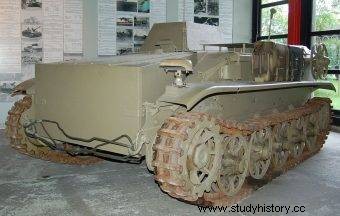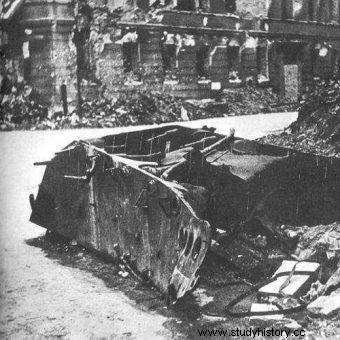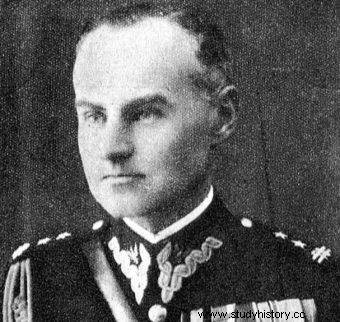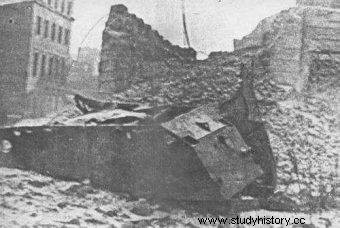On Sunday, August 13, 1944, shortly after 6 p.m., a monstrous explosion shook the Old Town. About three hundred people died - residents of Warsaw and soldiers. Over a hundred were injured. In national mythology, the tragedy is recorded as "the explosion of a trap tank." Meanwhile, it was neither a tank nor a trap.

Schwerer Ladungsträger Borgward B IV (Sd.Kfz. 301) at the Deutsches Panzermuseum in Munster
On Sunday, August 13, 1944, shortly after 6 p.m., a monstrous explosion shook the insurgent Old Town. About three hundred people died - residents of Warsaw and soldiers. Over a hundred were injured. In national mythology, the tragedy is recorded as "the explosion of a trap tank." Meanwhile, it was neither a tank nor a trap.
On the morning of August 13, 1944, two Sturmgeschütz 40 Ausf assault guns entered the Castle Square in Warsaw from the side of the Pancer Viaduct. G. The barricades on Świętojańska and Piwna Streets were fired. Then a small armored vehicle set off towards Podwale. He reached the redoubt defended by the Scouting Company of the "Gustaw" Battalion, stuck in it and stopped. When the insurgents threw gasoline bottles, the driver escaped from the car. The fire was extinguished, but the strange vehicle remained on the rampart.
Armored Trojan Horse?
As it was one of the first (if not the first) attacks in Warsaw using such a structure, the soldiers had no idea what they were dealing with. Finally, under the fire of machine guns placed on the towers of the Royal Castle and the Church of St. Anny, Cadet Ludwik Wyporek, pseudonym "Mietus", jumped into the vehicle. There were only two shaft grenades inside, so he reported the vehicle was unarmed. He noticed, however, that it had a large Blaupunkt radio station with bundles of cables hanging around it. From this he concluded that it was probably used to bring ammunition to the front line.
Still not sure if the car posed a threat, Captain Ludwik Gawrych, commander of the "Gustaw" Battalion, gave the order to leave it in its place. He only withdrew the barricade crew by several dozen meters. He also personally reported to Major Stanisław Błaszczak, the commander of the "Róg" Group. The latter, in turn, at 3:30 p.m. gave the report to the commanding officer of the defense of the Old Town, Colonel Karol Ziemski, pseudonym "Wachnowski". Its content was as follows:“I have stopped a small reconnaissance tank near the Podwale barricade. The chauffeur ran away. In the evening I will partially dismantle the barricade and bring the tank in. ”
It was decided that the mysterious vehicle would be seen in the evening by Corporal Witold Piasecki "Wiktor", the battalion's pyrotechnician. Unfortunately, this did not happen. When Piasecki reached the barricade, the "little leopard print" - as the machine was called - had already started its triumphant parade and was making its way through the enthusiastic crowd.

Vehicle wreckage - mines on Kilińskiego Street.
How did it come about? Well, around 4:00 pm young shooters from Kompania Motorowa "Orlęta" of the "Gozdawa" battalion reported to Podwale. They announced that they had orders to introduce the "tank" within the insurgent positions. Who gave the command? Could not be established. If it was not the Orlak's lawlessness, only three officers could have issued it. Clues point to one of them, but no hard evidence is available.
Part of the barricade was soon pulled down. It was decided that the vehicle would be launched and driven deep into the district by Corporal Henryk Paczkowski, pseudonym "Zbyszek" and 18-year-old shooter Zygmunt Salwa, pseudonym "Cobo". From Podwale, they turned into Kapitulna Street, and then Piekarska and Zapiecek reached the market square. They only stopped in front of the tenement house near Murzynek, where the command of the "Róg" group was based.
After a few minutes, the alleged "tankette" continued its journey. She crossed Nowomiejska, Freta and Podwale Streets until she reached the intersection with Kilińskiego. There the road was blocked by a small dam made of paving slabs. Several rows were hastily removed from it so that the driver could overcome the rest of the tank. Unfortunately, it is stuck on a small embankment. As he manipulated the levers to free himself, a steel crate slipped from the front of the vehicle. Someone yelled it was a tool box. It was decided to put them on the "camouflage" again. Then it exploded.
Hurricane of fire
The historian Łukasz Mieszkowski asked the sapper, sub-inspector Zbigniew Pluciak, to describe the effects of the explosion of five hundred kilograms of TNT. What follows is like a real hell. The energy released in the explosion formed a fireball with a temperature of 3,000 degrees. It created a zone of overpressure thousands of times the pressure of the atmosphere. The blast gasses struck a wave that traveled concentrically at a speed of 25,000 kilometers per hour. Only after her came the deafening thunder.
People standing by the "tankette" ceased to exist in an instant. No trace of them remained. Those who were a few meters away were torn to shreds. Their broken bones, buttons, buckles, coins, knives and eagles, together with the rubble, splinters of glass and metal torn from the ground, shocked those who stood away. The debris rotated inside the bodies, causing terrible damage. Doctor Tadeusz Pogórski, pseudonym "Morwa", reported that even the hair of other victims of the blast was removed from the wounds.
At the same time, the walls gave way and swayed. A tenement house at 3 Kilińskiego Street, which housed a storage of gasoline bottles, was set on fire. The explosion forced the viewers in the windows into their apartments. The balconies collapsed with the people. Even people standing several meters from the epicenter were badly burned. The explosion tore their arms and legs away. Glass particles stuck to faces and eyes, blinding many. More people were also killed by exploding grenades and ammunition from the killed soldiers.

The commander of the defense of the Old Town, Colonel Karol Ziemski, pseudonym "Wachnowski"
The explosion may not have "shot" people into the sky, as suggested by the makers of the film "Miasto '44", but pushed them into the walls of buildings. Tatters of bodies hung from gutters, cornices, windows, balconies, and lanterns. They were found in apartments, basements and backyards. And it wasn't over. The last victims were picked up by a vacuum created by a fiery blast. For the survivors, it burst their lungs. A deep depression at the epicenter caused the hurricane wind to change direction, now sucking in and throwing people from the gates and apartments right into the center of hell. He hurled them against the pavement along with the rain of broken glass.
It lasted… just a second. As it passed, the canyon created on Kilińskiego Street was filled with thick smoke, saturated with the smell of burnt bodies. Moans of the wounded were heard from everywhere. Father Tomasz Rostworowski was walking among the dying, giving the last rites.
Common exposure
The platoon of liaison officers of Kompania Motorowa "Orlęta" suffered the greatest losses as a result of the explosion. Seventeen of the thirty boys died. The decimated company "Gertrude" from the "Gustaw" Battalion was soon disbanded. The 2nd company of the "Wigry" Battalion recorded 14 killed and 59 wounded. Many of them, lying in insurgent hospitals, were shot by Germans, Turkmen and Azeris on September 2, 1944.
The inhabitants of the Old Town and refugees from Wola also died in the explosion. The list of victims included Polish, Jewish, German and one Tatar - Jan Emir Hassen. Among others, the popular actor Józef Orwid, known from the movie "Pani Minister Dances", was killed. Many children died. In this sense, hecatomb was a confirmation of Miron Białoszewski's thesis about the universality of the uprising.
The "tank" was close to liquidating ... the Home Army Headquarters. It would be enough for him to drive a few more meters. The first line of the army command was stationed just around the corner, at 7 Dluga Street, and that's where the echo of the detonation reached. General Tadeusz Bór-Komorowski himself suffered an injury.
The fallen were buried at Kilinskiego Street. In the spring of 1945, 327 bodies were found in the nearby graves and hospitals, where the murdered were still lying on mattresses. In addition, in the courtyard of the Raczyński Palace, the PCK commission counted the ashes of sixty burned people. This first exhumation was used only to bury the dead in a mass grave in the Krasiński Garden. It was only after two years that they were transferred to the insurgent quarters in the Military Cemetery.
The Porters of Death
Where did the vehicle that caused the explosion on Kilińskiego Street come from in Warsaw? He came from the 302nd Panzer Battalion (Fkl), which meant radio-controlled tanks. After the fighting in Normandy, the unit was directed to Ukraine, but never arrived there. On August 8, when she was in Kraków, her route was changed to Warsaw. The first flush was unloaded in the capital on August 11, 1944. Another four came by August 18.
The branch had as many as 108 engineers vehicles ( Schwerer Ladungsträger Sonderkraftfahrzeug 301 Ausf. C, also called Borgward B IV) and 24 self-propelled assault guns (S turmgeschütz 40 Ausf. G). In addition, it was equipped with 10 heavy artillery tractors ( Sonderkraftfahrzeug 9 ) and three command tanks ( Panzerbefehlswagen IV) . They were assigned to units of the corps commanded by Erich von dem Bach-Zelewski, which attacked the Old Town, Śródmieście, Mokotów and Żoliborz.
German for Schwerer Ladungsträger in the exact translation it means "heavy payload carrier" (implied:explosives). Unlike the little Goliath ( Sd.Kfz. 303 ) and medium Springer ( Sd.Kfz. 304 ), Borgward IV was the only "demolition vehicle". This meant that it did not explode, but left a powerful face.

Wreck of the mine vehicle on Kilińskiego Street, August 13, 1944
The driver was driving the vehicle close to the enemy's positions. It was already remotely directed to the enemy border. There the crate of TNT was dumped. The mechanism with delayed ignition was activated automatically after hitting the ground, and the "porter" himself returned. Radio control was unreliable, however, so a significant part of B IV "died" along with the loads. These cars were very often confused with German tanks. Meanwhile, most of the armored vehicles crashed by the insurgents and called "tigers" were Borgward.
It is worth adding that this particular model - produced in about 1,000 copies - has not received good reviews anywhere. It was used in the siege of Sevastopol, the Battle of the Kursk and Anzio. The commanders could not even determine how successive machines were destroyed, as their operators most often died. They were even called "living coffins".
Imagination Explosion
However, the Polish observers and witnesses of the tragedy did not know all this. The day after the explosion on Kilińskiego Street, newspapers in the Old Town wrote about "German crime" and "hideous deception". It was commonly accepted that it was a trap-tank. It has been speculated that it contained "a huge amount of dynamite" which was detonated using a "clock mechanism". It was reported meticulously that in the "intentionally planted tank", there was a "time bomb in a cache under the floor".
It was another proof of the enemy's perfidy. Here, the Germans were unable to defeat the insurgents in honorable combat, so they resorted to satanic deception. Fantasies about "German treason" were recorded by eminent historians and diarists:Adam Borkiewicz, Władysław Bartoszewski, Miron Białoszewski, Stanisław Podleski and Antoni Przygoński.
We can see traces of this interpretation of the event until today. They are given by the witnesses of the drama themselves, such as Kamila Merwatowa, a nurse from the Old Town, quoted by Wojciech Lada in an article that appeared in CiekawostkiHistorycznych.pl at the end of July 2016. She recalled:“Around August 18, the Germans released a tank loaded with explosives to Kiliński Square. Our boys didn't know that it was such a sinister trick on their part. ”
It is probably about the explosion on Kilińskiego Street. Meanwhile, the Germans could not "release" the tank there. Both on August 13 (the day of the explosion) and August 18 (the date given by Merwatowa), the tank would first have to overcome some fortified ramparts. Only insurgents could reach Kilinskiego Street. And unfortunately they arrived.
The symbolic potential of the myth
During the siege of the Old Town, 30,000 civilians and 7,000 soldiers were killed. Every day, the district was attacked several times by three Stukas, i.e. light bombers, which dropped three tons of bombs with each approach. More people have died in such air raids than during the August 13 explosion. Why is the tragic explosion, and not mass executions or bombings that carried away entire houses from the surface, gained such a symbolic status?
Perhaps it was so because during the Warsaw Uprising no other situation was experienced where in one second enthusiasm and joy turned into despair and trauma. It was the perfect metaphor for a romantic spurt and at the same time allowed to counter the knightly struggle of the insurgents to the criminal perfidy of the Nazis.
In fact, the tragedy of the Old Town may symbolize the failure of the uprising. But not necessarily in the sense that Poles would like to see it. For if it turned out that the explosion was the result of our audacity and lack of knowledge of the war craft, it would be more difficult to justify the misfortune and transfer the blame to the enemy.

A place of commemoration of the victims of the explosion of a German tank.
The very experience of death was also exceptional, this time extremely drastic. It is true that the fights in Warsaw were bestial, but over time one got used to the threat of execution. Bombs, in turn, buried people under the rubble. The victims were retrieved one by one, gradually. Meanwhile, on Kilinskiego Street, the survivors were wiping the blood and brains of the fallen. They were not in the audience, but on the scene of a murder, the indecency of which could by no means be applied to the beautiful vision of death for the motherland, where "a foreign bullet pierced my breast ...".
Satan's conspiracy
Unfortunately, no consequences were drawn from the tragic mistake. Only Captain Ludwik Gawrych demanded an investigation and prosecution of those guilty of disregarding the danger. Of course, there was no investigation. Everyone was fine with the "official" version about the German trap.
Could the Germans really have devised a satanic plan? They could, but for what? Warsaw was bombed from Okęcie by Junkersy 87 Stuka D and the heaviest mortar of World War II, Karl-Gerät 040 ZIU . The latter was launching two-ton missiles from the Sowiński Park in Wola. Missiles were fired into the city from the Stuka zu fuß launcher Also known as Nebelwerfer , or "fog throwers". In the language of Varsovians, they were referred to as cows or wardrobes.
In addition, 75 armored trains were shelling from the Wola, Powązki and Old Town railway line, and the "Pionier" cutter from the Vistula. Besides, the moguls, field cannons and armored vehicle guns worked hard. The Nazis had no reason to be bothered by the pitfalls.
Poles, on the other hand, faced the dissimilarity of recognizing shared responsibility. The insurgents would have to admit that they have no idea about German armor, that they are uncritical and hotheaded, that they cannot maintain discipline. It is not allowed to describe the heroes in this way, so instinctively, for the description of the tragedy, an acceptable interpretation was sought. And this could only be one:heroes and victims on one side of the barricade, and the personification of all evil on the other.
